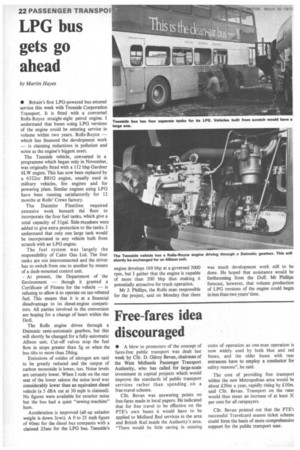LPG bus gets go ahead
Page 22

If you've noticed an error in this article please click here to report it so we can fix it.
by Martin Hayes
• Britain's first LPG-powered bus entered service this week with Teesside Corporation Transport. It is fitted with a converted Rolls-Royce straight-eight petrol engine. I understand that buses using LPG versions of the engine could be entering service in volume within two years. Rolls-Royce — which has financed the development work — is claiming reductions in pollution and noise as the engine's biggest asset.
The Teesside vehicle, converted in a programme which began only in November, was originally fitted with a 112 bhp Gardner 6LW engine. This has now been replaced by a 6522ec B81G engine, usually used in military vehicles, fire engines and for powering plant. Similar engines using LPG have been running satisfactorily for 12 months at Rolls' Crewe factory.
The Daimler Fleetline required extensive work beneath the floor to incorporate the four fuel tanks, which give a total capacity of 51gal. Side-members were added to give extra protection to the tanks. I understand that only one large tank would be incorporated in any vehicle built from scratch with an LPG engine.
The fuel system was largely the responsibility of Calor Gas Ltd. The four tanks are not interconnected and the driver has to switch from one to another by means of a dash-mounted control unit.
At present, the Department of the Environment — though it granted a Certificate of Fitness for the vehicle is refusing to allow it to operate on tax-rebated fuel. This means that it is at a financial disadvantage to its diesel-engine competitors. All parties involved in the conversion are hoping for a change of heart within the DoE The Rolls engine drives through a Daimatic semi-automatic gearbox, but this will shortly be changed for a fully-automatic Allison unit. Cut-off valves stop the fuel flow in stops greater than 5g or when the bus tilts to more than 28deg.
Emissions of oxides of nitrogen are said to be greatly reduced and the output of carbon monoxide is lower, too. Noise levels are certainly lower. When I rode on the rear seat of the lower saloon the noise level was considerably lower than an equivalent diesel vehicle (a 5 dBA cut at 30 mph is claimed). No figures were available for exterior noise but the bus had a quiet "sewing-machine" hum.
Acceleration is improved (all-up unladen weight is down 3cwt). A 0 to 25 mph figure of 40sec for the diesel bus compares with a claimed 25sec for the LPG bus. Teesside's
engine develops 160 bhp at a governed 3000 rpm, but I gather that the engine is capable of more than 200 bhp thus making it potentially attractive for truck operation.
Mr J. Phillips, the Rolls man responsible for the project, said on Monday that there was much development work still to be done. He hoped that assistance would be forthcoming from the DoE. Mr Phillips forecast, however, that volume production of LPG versions of the engine could begin in less than two years' time.










































































































